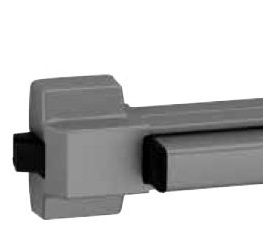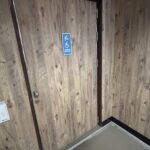This was the very first post written on iDigHardware back in 2009. I’m saving it for posterity, but there is an updated article on the NEC requirements for panic hardware on electrical rooms. Click here for the updated article.
~~~
Beginning with the 2002 edition, the National Electric Code (NFPA 70) requires that certain types of electric rooms have doors that open in the direction of egress and are “equipped with panic bars, pressure plates, or other devices that are normally latched but open under simple pressure.” According to an engineer I spoke with at the National Fire Protection Association, the releasing device could be a hospital latch or paddle-type release, but the fact that the words “panic bar” are used in the Code has prompted many code officials to require panic hardware.
According to Article 110 of the National Electric Code, personnel doors serving the following types of rooms must comply:
- Rooms housing large equipment – 600 Volts, nominal or less, 1200 amperes or more.
- Rooms housing conductors and equipment used on circuits of over 600 Volts, nominal.
- Transformer Vaults
A common question is whether pairs of electric room doors require panic hardware on both leaves. The National Electric Code does not address this. If I am specifying hardware for a new pair of doors, I specify Von Duprin 2227 exit devices on both leaves. If it is an existing pair or an unequal leaf pair, I specify manual flush bolts on the inactive leaf with a Von Duprin 2227L-F on the active leaf.
—————————————————————————————
This is the actual language from the National Electric Code (NFPA 70):
The following language occurs in the section called “600 Volts Nominal or Less”, in Article 110, “Requirements for Electrical Installations”.
(2) Large Equipment. For equipment rated 1200 amperes or more and over 1.8 m (6 ft) wide that contains overcurrent devices, switching devices, or control devices, there shall be one entrance to the required working space not less than 610 mm (24 in.) wide and 2.0 m (6 ft) high at each end of the working space. Where the entrance has a personnel door(s), the door(s) shall open in the direction of egress and be equipped with panic bars, pressure plates, or other devices that are normally latched but open under simple pressure.
The following language occurs in the section called “Over 600 Volts, Nominal”, in Article 110, “Requirements for Electrical Installations”.
110.33 Entrance and Access to Work Space.
(A) Entrance. At least one entrance not less than 610 mm (24 in.) wide and 2.0 m (6 ft) high shall be provided to give access to the working space about electric equipment. Where the entrance has a personnel door(s), the door(s) shall open in the direction of egress and be equipped with panic bars, pressure plates, or other devices that are normally latched but open under simple pressure.
The following language occurs in the section called “Transformer Vaults”, in Article 450, “Transformers and Transformer Vaults”.
(C) Locks. Doors shall be equipped with locks, and doors shall be kept locked, access being allowed only to qualified persons. Personnel doors shall swing out and be equipped with panic bars, pressure plates, or other devices that are normally latched but open under simple pressure.
————————————————————————————– 
The Von Duprin 22 series exit device is an economical and durable solution for electric room doors which require panic hardware.
You need to login or register to bookmark/favorite this content.






Hi Lori!
I received two phone calls in as many days from different architects and both citing a 2008 National Electric Code requirement (for doors servicing electrical rooms) which states that, if there is an electrical panel located within 25″ of the door, then the door must swing out and have panic hardware. Have you seen or heard of this requirement?
I was just sent a copy of the paragraph…..
110.33 (A) (3) Personnel Doors. Where there is a personnel door(s) intended for entrance to and egress from the working space less than 7.6 m (25 ft) from the nearest edge of the working space, the door(s) shall open in the direction of egress and be equipped with panic bars, presure plates, or other devices that are normally latched but open under simple pressure.
Lori, I am looking for a software to help me do my estimating, can you suggest what to buy.
Thank you,
Are the existing doors required to be upgraded or just when repaired? It makes the understanding it to be all rooms and existing personal egress doors to comply as this is a good question.
The other part of the question is the use of lever handles as it states panic bar but some are allowing levers so not to have to replace existing doors?
We have seen a few things around BC and have tried to talk to architects about the set up as they have used older code (not up to date) as we have it on a laptop so to stay on top but they seem to think its not in their books its not code.
Hi Robert –
I have definitely heard of AHJs requiring existing doors to be brought up to current code regarding this issue. There may be AHJs who are not doing so, but some are. Regarding the levers…in my opinion that doesn’t meet the intent of the code. I take the term “simple pressure” to mean just pushing on the hardware in the direction of egress would release the latch. I think a hospital latch (on an outswinging door) would meet the intent, but because the term “panic bar” is used, most AHJs are requiring panic hardware / fire exit hardware.
The question we have is about transformer vault blast doors and when are they reqired. We have been asked about the differences on the door replacement of doors on large transformer rooms. As the difference is in the type (dry or liquid) transformer we are asking for oil filled. There is a room concrete room with a 13800kv to 480 kv. The question we see is where is a blast door required on a vault door or can the old blast door be replaced with a rated door and frame with panic.?
Hi Robert –
I don’t know the answer to that one. You might want to post the question on the Building Codes Forum – I’m sure one of their members would know. http://www.inspectpa.com/forum/
– Lori
PREVIEW and download the 2014 (NEC) National Electrical Code at
http://kapowbooks.com/nfpa-fire-70-national-electrical-code-nec-2014-edition/